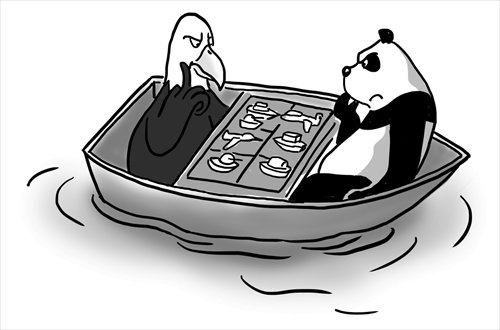HOME >> OP-ED
New power balance needed in S.China Sea
By Ding Gang Source:Global Times Published: 2016/7/6 22:18:01

Illustration: Liu Rui/GT
The Permanent Court of Arbitration at The Hague will on July 12 issue the award on the South China Sea case filed by the Philippines against China. As the date is drawing close, the situation between Beijing and Washington is becoming tense. It seems that the two will stage a decisive battle in the South China Sea.
Why have territorial disputes between China and the Philippines led to a sharp confrontation between China and the US?
The fundamental reason is that the power balance between China and the US in the region has changed substantially. China is becoming the dominant economic and military power in the region.
The Americans see clearly that China's strategic intention in the South China Sea has not changed. Those who repeatedly ask China to state explicitly its military intention are deliberately creating an atmosphere that hypes up the so-called China threat.
China's defensive rather than offensive actions are within its proactive national defense policies. China will not send warships or planes close to US boundaries.
China has been doing what any other sovereign country would do. Its actions in the South China Sea are a result of the rising prowess that allows it to better exercise its right of control over territories. They have nothing to do with regaining lost territories.
The presence of military forces in the South China Sea will inevitabily shift. The rising economic power of China will certainly lead to its military ramping-up. And China is obliged to offer more public goods to the world.
The US is worried that China's rising strength will challenge the Asia-Pacific security pattern established by Washington, which will squeeze its strategic space.
In the eyes of the US, the South China Sea is the key region of strategic imbalance in the Asia Pacific. The US must consolidate its strategic advantages by military re-arrangement and offshore manipulation.
Increasing military deployment has been an important component of the rebalancing to the Asia Pacific strategy adopted by the Obama administration. The US Navy is now deploying some 60 percent of its forces to the Pacific. American hawks also advocate preparing for a war.
But from China's perspective, the strategic pattern in the South China Sea must have new balance. Beijing believes that only through enhancing its military presence and changing the previous military balance on its doorstep can it maintain its sovereign integrity.
Through decade-long efforts, China has become an important military power in the South China Sea and the West Pacific. It can effectively take countermeasures against US surveillance close to its territory.
It seems that China's military advancement in the region has provoked the US, which makes the situation hard to control. But in the long run, the best way to check US forces in the region is to create a balance of power. A more effective risk-control mechanism depends on the development of a more balanced structure.
Modern Chinese writer Ma De wrote that the quality of communications depends on distance. This principle can be applied to exchanges between China and the US in the South China Sea. The best risk-control method is to keep the other at a distance.
The author is a senior editor with People's Daily, and currently a senior fellow with the Chongyang Institute for Financial Studies at Renmin University of China. dinggang@globaltimes.com.cn Follow him on Twitter at @dinggangchina
Posted in: Ding Gang, Asian Review